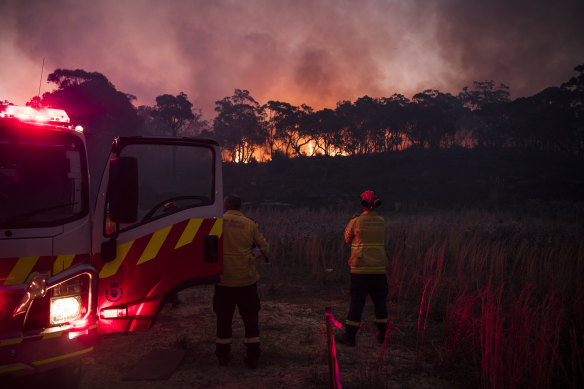This was published 10 months ago
Opinion
Hazard reduction shouldn’t be hazardous. So why the escaped fire at Oxford Falls?
Ian Brown
Bushfire management advocateThe escape of the planned burn near Oxford Falls in Sydney’s northern beaches last Saturday threatened lives and property. It provoked a large and costly response, spreading from a small intended area to almost 150 hectares. With uncanny echoes of some of the backburning problems during our Black Summer – including in the Blue Mountains – the incident raises questions for the fire agencies, the community and the government.
Let’s be clear: lighting a new bushfire is always a risk, whether it’s done outside the fire season to reduce fuels or a backburn to contain a wildfire. Some burns do escape, to enlarge both the fire and the dangers. This risk is managed through standards, training, planning and procedures – more so with hazard reductions, which provide more time and choice compared to high-pressure wildfire situations. Most burn planning and approval is done by the paid staff of fire agencies.

Rural Fire Service (RFS) firefighters monitor a bushfire that began with a hazard reduction burn near Oxford Falls on Saturday.Credit: Andrew Quilty
Off-season planned burns close to residential areas are complex and risky, so they are carefully planned within a specific weather prescription that will achieve enough burning with a low risk of escape. This is especially important when a burn is close to an aged care or similar facility.
So what happened last Saturday? There has been no detailed explanation. Statements about blowing embers, weather and high fuel levels don’t cut it and just raise more questions. All these factors are part of the planning. It’s essential to dig deeper. Pre-emptive explanations also endanger the more considered investigation which now needs to happen. It must not look for blame but for learnings.
Fire is a tricky business, and unintended outcomes are usually the result of multiple factors. The pressure to achieve burning programs and to “get the job done” on the day is understandable. Climate change and the availability of volunteers are squeezing “windows” to do burns safely. Spring is a risky season, adding to other risks.
Burns can go wrong in planning, resourcing, approval on the day and how they are implemented. Was the northern beaches burn within the prescribed and forecast weather conditions? Was it lit to the appropriate pattern and speed? Were adopted burning guidelines followed? What did witnesses see, and exactly how did it cross the line? What contingency planning was done in the event of escape? So many details are crucial, but the key overall question is: could the breakout have been avoided, and if so, how?
Let’s not pretend that the “expanded” burn was a good outcome. Some local brigades and residents may be relieved that there is reduced risk in the area for a few summers, but breakouts are dangerous, and this one could have turned even more disastrous. The whole bush block is now burnt, making future fire management more difficult.
When things go wrong the most important response is analysis, so that future problems can be minimised. Volunteers need to be supported with the best evidence and learnings for future burns, within a rigorous risk management system. Most veteran firefighters would agree that something can be learnt from any fire.
But not enough analysis is happening. The 2020 NSW Bushfire Inquiry recommended detailed research on backburning, but the only outcome is a 2022 Commonwealth-funded pilot study by the University of Wollongong (which is still under wraps), with no feedback to on-ground firefighters.
Hard-working volunteers are not getting the support they need from the professional organisation that surrounds them. Many are expressing dismay about this latest escape on the Rural Fire Service Facebook page.
Independent oversight is essential to give firefighters and the community confidence that the right lessons are being learnt and that safety is paramount. NSW needs an inspector general of emergency management, as Queensland and Victoria have had since 2014. It would do positive work similar to the oversight bodies for other public safety industries such as police, the military and health.
The royal commission after the Black Summer fires recommended just such “assurance and accountability” bodies for the emergency sector in all states. The government has ignored this recommendation but must now act on it, and also ensure the escape of the Oxford Falls burn is independently reviewed, and the lessons acted on. If the inspector general was in place already, such a review would be routine.
Ian Brown is secretary of the Independent Bushfire Group, and a former national park manager and firefighter.